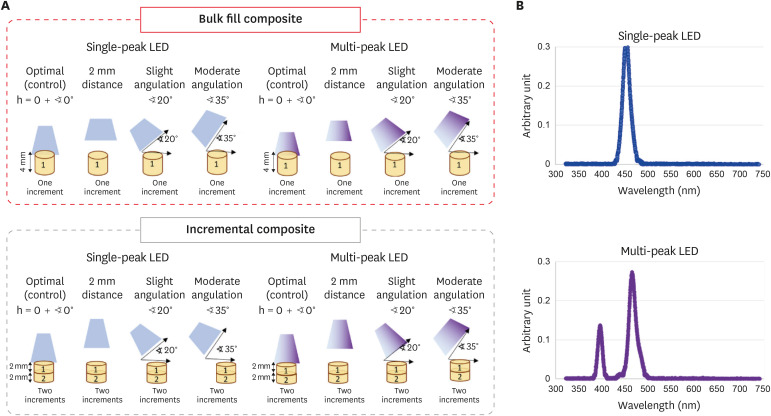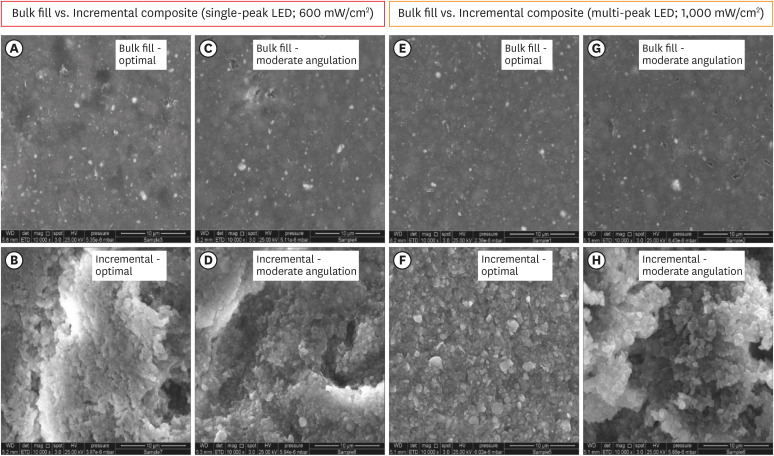1. AlShaafi MM. Factors affecting polymerization of resin-based composites: a literature review. Saudi Dent J. 2017; 29:48–58. PMID:
28490843.

2. Price RB, Ferracane JL, Shortall AC. Light-curing units: a review of what we need to know. J Dent Res. 2015; 94:1179–1186. PMID:
26156516.
3. de Oliveira DC, de Menezes LR, Gatti A, Correr Sobrinho L, Ferracane JL, Sinhoreti MA. Effect of nanofiller loading on cure efficiency and potential color change of model composites. J Esthet Restor Dent. 2016; 28:171–177. PMID:
26880567.

4. Alrahlah A, Silikas N, Watts DC. Post-cure depth of cure of bulk fill dental resin-composites. Dent Mater. 2014; 30:149–154. PMID:
24268044.

5. Gan JK, Yap AU, Cheong JW, Arista N, Tan C. Bulk-fill composites: effectiveness of cure with poly- and monowave curing lights and modes. Oper Dent. 2018; 43:136–143. PMID:
28976838.

6. Aggarwal N, Jain A, Gupta H, Abrol A, Singh C, Rapgay T. The comparative evaluation of depth of cure of bulk-fill composites - an
in vitro study. J Conserv Dent. 2019; 22:371–375. PMID:
31802822.

7. Van Ende A, De Munck J, Van Landuyt KL, Poitevin A, Peumans M, Van Meerbeek B. Bulk-filling of high C-factor posterior cavities: effect on adhesion to cavity-bottom dentin. Dent Mater. 2013; 29:269–277. PMID:
23228335.

8. Flury S, Hayoz S, Peutzfeldt A, Hüsler J, Lussi A. Depth of cure of resin composites: is the ISO 4049 method suitable for bulk fill materials? Dent Mater. 2012; 28:521–528. PMID:
22391146.

9. Azzopardi N, Moharamzadeh K, Wood DJ, Martin N, van Noort R. Effect of resin matrix composition on the translucency of experimental dental composite resins. Dent Mater. 2009; 25:1564–1568. PMID:
19709725.

10. Price RB, Ferracane JL, Hickel R, Sullivan B. The light-curing unit: an essential piece of dental equipment. Int Dent J. 2020; 70:407–417. PMID:
32696512.

11. Derchi G, Vano M, Ceseracciu L, Diaspro A, Salerno M. Stiffness effect of using polywave or monowave LED units for photo-curing different bulk fill composites. Dent Mater J. 2018; 37:709–716. PMID:
30047507.

12. Menees TS, Lin CP, Kojic DD, Burgess JO, Lawson NC. Depth of cure of bulk fill composites with monowave and polywave curing lights. Am J Dent. 2015; 28:357–361. PMID:
26897758.
13. Maktabi H, Balhaddad AA, Alkhubaizi Q, Strassler H, Melo MAS. Factors influencing success of radiant exposure in light-curing posterior dental composite in the clinical setting. Am J Dent. 2018; 31:320–328. PMID:
30658380.
14. Konerding KL, Heyder M, Kranz S, Guellmar A, Voelpel A, Watts DC, Jandt KD, Sigusch BW. Study of energy transfer by different light curing units into a class III restoration as a function of tilt angle and distance, using a MARC Patient Simulator (PS). Dent Mater. 2016; 32:676–686. PMID:
27017156.

15. Al-Zain AO, Eckert GJ, Lukic H, Megremis S, Platt JA. Polymerization pattern characterization within a resin-based composite cured using different curing units at two distances. Clin Oral Investig. 2019; 23:3995–4010.

16. Eshmawi YT, Al-Zain AO, Eckert GJ, Platt JA. Variation in composite degree of conversion and microflexural strength for different curing lights and surface locations. J Am Dent Assoc. 2018; 149:893–902. PMID:
30149887.

17. Janda R, Roulet JF, Latta M, Steffin G, Rüttermann S. Color stability of resin-based filling materials after aging when cured with plasma or halogen light. Eur J Oral Sci. 2005; 113:251–257. PMID:
15953251.

18. Maktabi H, Ibrahim M, Alkhubaizi Q, Weir M, Xu H, Strassler H, Fugolin APP, Pfeifer CS, Melo MAS. Underperforming light curing procedures trigger detrimental irradiance-dependent biofilm response on incrementally placed dental composites. J Dent. 2019; 88:103110. PMID:
31022421.

19. Meireles SS, Demarco FF, dos Santos IS, Dumith SC, Bona AD. Validation and reliability of visual assessment with a shade guide for tooth-color classification. Oper Dent. 2008; 33:121–126. PMID:
18435184.

20. Atai M, Yassini E, Amini M, Watts DC. The effect of a leucite-containing ceramic filler on the abrasive wear of dental composites. Dent Mater. 2007; 23:1181–1187. PMID:
17507087.

21. Poggio C, Lombardini M, Gaviati S, Chiesa M. Evaluation of Vickers hardness and depth of cure of six composite resins photo-activated with different polymerization modes. J Conserv Dent. 2012; 15:237–241. PMID:
22876009.

22. Balhaddad AA, Ibrahim MS, Weir MD, Xu HHK, Melo MAS. Concentration dependence of quaternary ammonium monomer on the design of high-performance bioactive composite for root caries restorations. Dent Mater. 2020; 36:e266–e278. PMID:
32527499.

23. Sabatini C. Color stability behavior of methacrylate-based resin composites polymerized with light-emitting diodes and quartz-tungsten-halogen. Oper Dent. 2015; 40:271–281. PMID:
25275958.

24. Diamantopoulou S, Papazoglou E, Margaritis V, Lynch CD, Kakaboura A. Change of optical properties of contemporary resin composites after one week and one month water ageing. J Dent. 2013; 41(Supplement 5):e62–e69.

25. Bendary IM, Garcia IM, Collares FM, Takimi A, Samuel SMW, Leitune VCB. Wollastonite as filler of an experimental dental adhesive. J Dent. 2020; 102:103472. PMID:
32927019.

26. Al-Zain AO, Eckert GJ, Platt JA. The influence of distance on radiant exposure and degree of conversion using different light-emitting-diode curing units. Oper Dent. 2019; 44:E133–E144. PMID:
30849014.
27. Ciccone-Nogueira JC, Borsatto MC, de Souza-Zaron WC, Ramos RP, Palma-Dibb RG. Microhardness of composite resins at different depths varying the post-irradiation time. J Appl Oral Sci. 2007; 15:305–309. PMID:
19089149.

28. de Camargo EJ, Moreschi E, Baseggio W, Cury JA, Pascotto RC. Composite depth of cure using four polymerization techniques. J Appl Oral Sci. 2009; 17:446–450. PMID:
19936524.

29. Moore BK, Platt JA, Borges G, Chu TM, Katsilieri I. Depth of cure of dental resin composites: ISO 4049 depth and microhardness of types of materials and shades. Oper Dent. 2008; 33:408–412. PMID:
18666498.
30. Mitwalli H, Alsahafi R, Balhaddad AA, Weir MD, Xu HHK, Melo MAS. Emerging contact-killing antibacterial strategies for developing anti-biofilm dental polymeric restorative materials. Bioengineering (Basel). 2020; 7:83.

31. Tantanuch S, Kukiattrakoon B, Peerasukprasert T, Chanmanee N, Chaisomboonphun P, Rodklai A. Surface roughness and erosion of nanohybrid and nanofilled resin composites after immersion in red and white wine. J Conserv Dent. 2016; 19:51–55. PMID:
26957794.













 PDF
PDF Citation
Citation Print
Print



 XML Download
XML Download